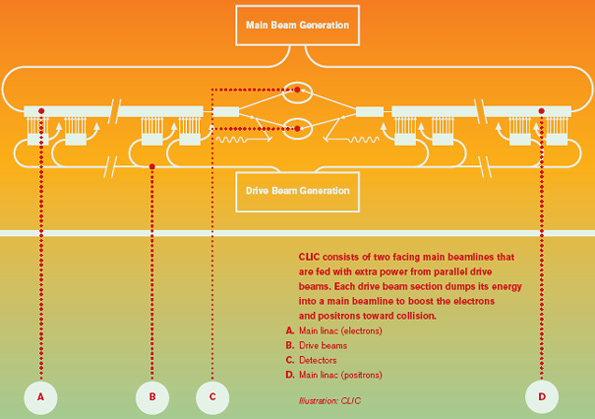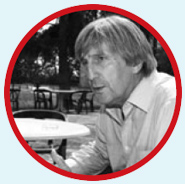CLIC: The Compact Linear Collider
by Elizabeth Clements
reporting from Geneva, Switzerland
As the Global Design Effort for the proposed International Linear Collider starts to take shape, an international collaboration of scientists simultaneously works on an alternative linear collider technology that pushes physics and engineering to the edge.
 |
At the end of this decade, new-found answers to some of nature's biggest mysteries will determine the future of particle physics.
By 2010, members of the Global Design Effort will produce a detailed engineering design for the International Linear Collider. By the same year, a small international collaboration aims to prove that the Compact Linear Collider (CLIC)—a machine that can potentially reach about five times the energy of the ILC—is a feasible project. But before either machine is built, the physics of the Large Hadron Collider (LHC), scheduled to come online in 2007 at the European laboratory CERN, will tell us how much energy we actually need to explore the future frontier of particle physics.
Based at CERN, Switzerland, CLIC is an ambitious project that proposes colliding beams of positrons and electrons at an energy of 3 TeV (teraelectronvoltsthousands of billions of electronvolts). It would achieve this by using a new accelerating technology to reach the multi-TeV energy range in approximately the same distance that the ILC would require to reach its 0.5-1 TeV design specification.
CLIC, however, is not an easy project. From building the novel power supply to squeezing the beam down to a diameter of about a nano-meter at the collision point, CLIC faces many obstacles that must be overcome before it can be considered as a future project for the particle physics field.
While CLIC proceeds to test its technology, ILC R&D continues to move forward. In August 2004, the International Committee for Future Accelerators (ICFA) endorsed the recommendation for superconducting radiofrequency technology, a proven technology, as the basis for the collider's main linear accelerator design. Seven months later, during the Linear Collider Workshop at Stanford University in March 2005, Barry Barish accepted his appointment as the director of the GDE. Since that time, Barish has started to form a Central Management Team for the GDE, putting the ILC R&D at least five years ahead of CLIC.
"You have to be working toward the future at any given time," Barish says. "My plan is to do an engineering design in great detail with motivations and reasons that will match the science. Whether the ILC should be built or not will be determined in the early years of the LHC. But if you look at all of the physics as we understand it today, there is a lot of evidence that points to the ILC energy regime."
CLIC project leader Jean-Pierre Delahaye supports R&D for both projects.
"We have to do everything we can to optimize the ILC at a minimum cost such that it can be built as soon as possible if and when the budget can be found and the physics interest is validated," he says. "We also believe that it is our responsibility to work on R&D for CLIC in order to explore all different kinds of technology and as a safety net for the ILC. What if the cost of the ILC is too much? Or what if we need a higher energy? Moreover, the CLIC technology, when demonstrated to be feasible, will reinforce the ILC by possibly extending Linear Colliders into the multi-TeV energy range. It would be irresponsible to not do everything for the ILC and explore other options at the same time."
For Barish and Delahaye, it is clear that both projects must be pursued simultaneously in order to ensure that a linear collider giving access to the new energy frontier will be built as soon as possible. It is really just a question of determining which machine is best suited for the needs of the particle physics field. But that is up to the physics to decide.
 Jean-Pierre Delahaye, CLIC project leader. Photo: Max Brice, CERN |
The CLIC physics menu
"CLIC can do what a TeV collider can do with precision, but it can do more," says Albert De Roeck, a CERN physicist who is a member of the CMS experiment at the Large Hadron Collider.
The LHC will give physicists a first glimpse into a new realm of particle physics discoveries. Physicists anticipate that the Higgs boson, the particle thought to give all other particles mass, will be one of the first discoveries. But the big question is, will the Higgs be a light particle or a heavy particle?
If the Higgs exists at an energy below about 300 GeV, as theoretical constraints and experiments at Fermilab, SLAC, and CERN suggest, the ILC will be sufficient. But if the Higgs or a similar particle is much heavier and can only be produced with a multi-TeV machine, then CLIC will become necessary.
"A multi-TeV machine will verify the discovery," De Roeck says. "Due to the higher energy and luminosity, CLIC can be a good machine for measuring more subtle properties of the light Higgs and especially good for the discovery and measurements of the heavy Higgs.
"If supersymmetry exists, does it have a high mass or a low mass? CLIC would be the machine that can measure sparticles with masses even larger than 500 GeV very precisely. We don't know where supersymmetry is or if it exists, but we know it's possible."
Searches for extra dimensions and new particle interactions are also on the physics menu for CLIC. Approximately 70 to 80 physicists, many dedicated to LHC physics and only working part-time on the CLIC project, developed a substantial list of scientific goals for CLIC. "All of the physics goes well beyond what the LHC will be able to do, but it is also very complementary," De Roeck said.
An alternative technology
If CLIC used the same acceleration technology as the ILC, it would need to be 118 km long to reach its energy goal.
In order to build a 30-kilometer, multi-TeV collider with a proposed luminosity of 1035 cm-2 sec-1, ten times brighter than SLAC's PEP-II collider, scientists would use a novel two-beam accelerating technique, distinguishing it from other proposed projects.
High acceleration gradients (the amount of acceleration per meter of machine) are necessary to limit the length of a multi-TeV machine and its price tag. Such high gradients are easier to achieve with electric fields oscillating at high frequency. CLIC physicists selected a frequency of 30 GHz (gigahertzbillions of oscillations per second), aiming to achieve a gradient of 150 million volts per meter. In comparison, the ILC will operate at a frequency of 1.3 GHz to produce a gradient of 35 million volts per meter.
In a conventional linear accelerator, the radio-frequency (rf) power used to accelerate the main beam is generated by devices called klystrons. They create rf waves in a similar way to microwave ovens. Because klystrons use so much power at high frequencies and a 3-TeV machine would require so many of them, CLIC scientists propose an innovative solution based on a two-beam accelerator scheme. High-intensity, low-energy "drive beams" run parallel to the main linear accelerator beams. Power is built up in the drive beams and then transferred in quick bursts to the main beams.
"Each drive beam powers a 670-meter-long section of the main linac," says Ian Wilson, CLIC deputy study leader at CERN. "At the end of each section, the drive beam is sent to a dump and another drive beam takes over, like a relay race."
CLIC will require 21 drive beams to reach 3 TeV. The distance between the drive beams and the main beams is only 60 cm, so the power is provided near where it is needed. This technique maximizes the energy transfer from the drive beam to the accelerated beam, making it an attractive solution for accelerator experts.
"What we are proposing is very complex," Wilson says. "We are really on the cutting edge and pushing along with the R&D to try to demonstrate very challenging issues. In the end, we will have a very advanced machine."
 A cross-section of the CLIC tunnel, which would have a diameter of 3.8 meters. Illustration: CLIC |
CLIC challenges
In 2003, an International Review Committee consisting of twenty physicists conducted a review of all technological options for linear colliders including CLIC. Gerald Dugan, the newly appointed Regional Director for the ILC-Americas Global Design Effort, was a member of the review panel.
"For approximately the same length of the ILC, you can have five times more energy with CLIC," Dugan says. "This is an advantage, but there are a number of obstacles. The review panel established a set of requirements that need to be satisfied in order to prove that CLIC is feasible. The CLIC team is working on these requirements now."
The panel found that one of the first requirements is achieving a high gradient in copper structures. In order to reach a high gradient of 150 million volts per meter, CLIC uses normal-conducting cavities instead of the superconducting cavities for the ILC. But during tests, the insides of the cavities became damaged. The CLIC team tested other materials and found that plating the copper structures with molybdenum or tungsten may be a solution. "We got very good results, but for short pulses," Wilson says. "We need to confirm these promising results with longer pulses. If we can get it to work, it will be a significant breakthrough."
Another major challenge is the power source technology. "In principle, CLIC's two-beam technology is very efficient, which is important," Dugan says. "But it is also very complicated. It is very important that the CLIC team demonstrates the power source is feasible."
Generating the proposed luminosity is yet another hurdle. "It is very important to reach a very high luminosity for the given amount of power," Wilson says. "For a 3 TeV collider with a luminosity of 1035 [cm-2 sec-1], the beams need to be squeezed down to a nanometer at the collision point."
A group of 30 full-time-equivalent staff are currently in the process of installing a new CLIC test facility (CTF3) in the old Large Electron Positron (LEP) pre-injector building at CERN. The test facility will consist of a drive beam accelerator, a delay loop, and a combiner ring that will enable scientists to demonstrate that CLIC technology is feasible.
Over the coming four years, the CLIC team will operate CTF3 to investigate and provide answers for the key R&D issues. By the end of 2009, just a year before the ILC will have a detailed engineering design, CLIC scientists hope to have experimental results that convince the particle physics community that a 3 TeV machine can be built.
 Ian Wilson, CLIC deputy study leader. Photo: Max Brice, CERN |
The collaboration
The CLIC study group has a material budget of 3.4 million Swiss francs (US$2.7 million) per year for the baseline program. The international collaboration consists of approximately one hundred scientists, but very few are working on the project full time. For Delahaye, establishing a global collaboration is a main priority. "We are building a collaboration that is very similar to what is done for detectors," he says. "We are asking laboratories and institutions to take responsibility for managing well identified work packages as parts of the project."
Institutions from such countries as Finland, France, Italy, Russia, Spain, Sweden, Turkey, the United Kingdom and the United States are already members of the CLIC collaboration. Discussions are currently under way with India and China. In addition to the R&D contribution of Stanford Linear Accelerator Center, the US Department of Energy has expressed interest in having more participation by the United States on high-gradient R&D for multi-TeV linear colliders.
"A number of different countries and labs have expressed interest," Delahaye says. "The design cannot be built for either the ILC or CLIC by one lab, and it shouldn't be done by one lab alone. R&D on novel schemes and challenging technologies require good ideas, which is always difficult. The good ideas come when we work together and exchange in fruitful multilateral collaboration with different countries and labs."
Let the physics decide
Five years from now, many questions about the future of particle physics should be closer to getting answered. Data from the LHC will be flowing. The feasibility of CLIC technology will be known. The ILC will have an engineering design.
Until then, rather than being on two different teams, ILC and CLIC scientists are working together for the future of the field.
"We feel that we are all working toward a common goal," says Steffen Doebert, a physicist at SLAC who has worked on both CLIC and the ILC. "We want to provide a machine for particle physics, and both CLIC and the ILC are very interesting R&D projects."
The overlap between the CLIC and the ILC teams recently grew stronger. On June 22, 2005, Barish announced that Delahaye will be a deputy to the ILC-Europe GDE Regional Director, Brian Foster.
"CLIC has very good and thoughtful people working on it," Barish says. "Both CLIC and the ILC can be pursued in parallel in this stage. The real question is whether you ultimately pursue the ILC, and we will know that once we see the physics from the early years of the LHC. Nature will have to tell us if it's the right machine."
Like many physicists on the ILC and CLIC, Delahaye considers himself to be an equal member of both R&D projects. "We are not competing but working together," he says. "We are all convinced that a linear collider needs to be built as soon as possible, and we need to work together to make that happen."
Click here to download the pdf version of this article.






